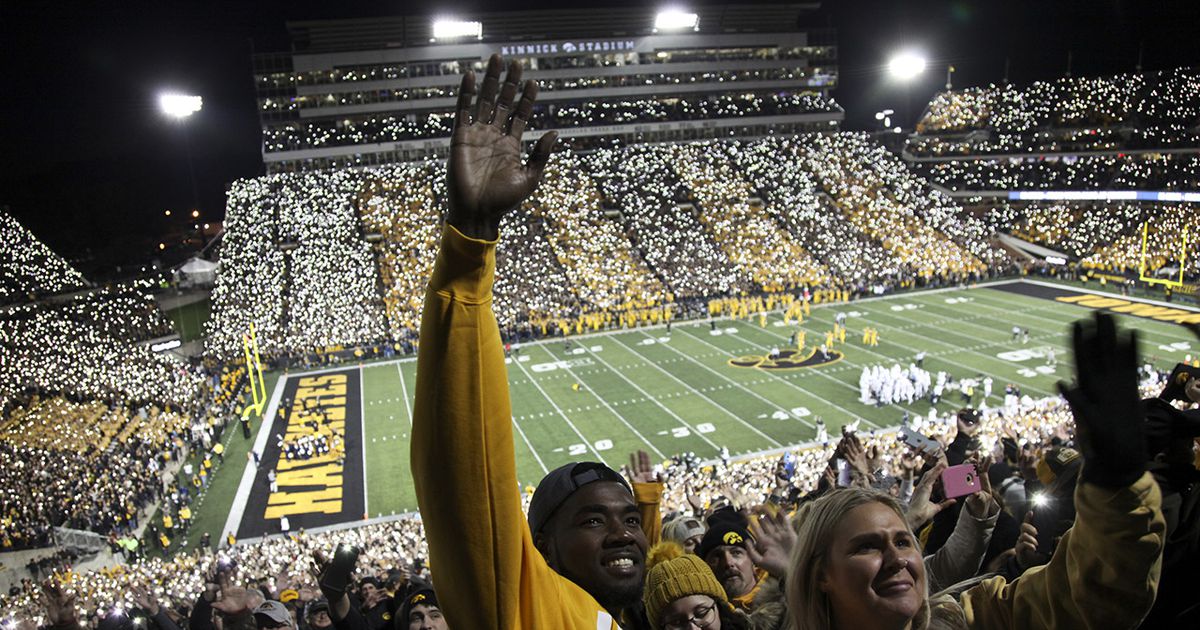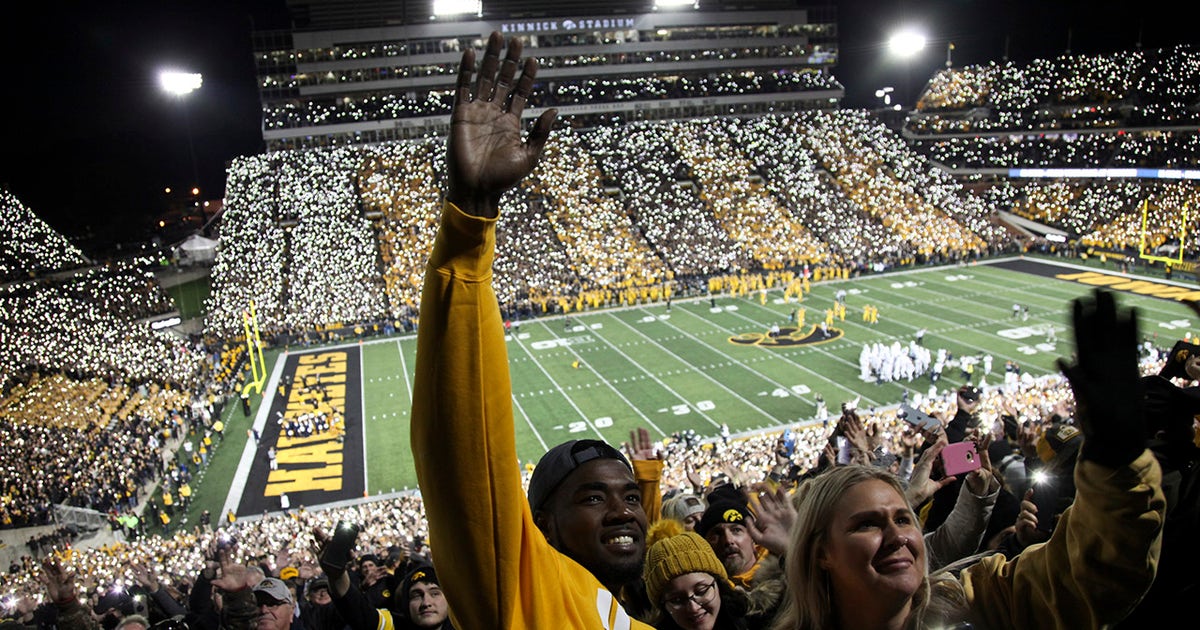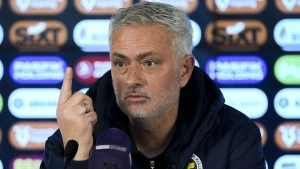College football’s most heartwarming tradition hits the road


Most sporting traditions have some kind of positive sentiment going for them, which is usually why they carry on long enough to become traditions in the first place.
That’s why we have good traditions and great traditions across athletics, traditions that are probably past their use-by date but persist regardless — cheesy traditions and silly traditions and everything in between.
And then, in a league entirely of its own regarding awesome things sports fans do at games, is the Kinnick Wave, the greatest, sweetest, noblest, simplest and most heartwarming activity that football supporters have come up with in the 150 years or so since the game was invented.
The Wave is something that television companies suspend commercial breaks for, players and coaches pause to witness, that onlookers openly weep at.
It is just a wave.
But when it is being carried out by 70,000 Iowa Hawkeyes fans at Kinnick Stadium and directed to a group of breathtakingly courageous children fighting cancer at a hospital overlooking the arena, it is everything.
*
Krista Young didn’t know what she was starting back in 2017, and she can still scarcely believe what it has become. On an online fan forum — and “on a whim” — Young suggested that the Hawkeye masses should turn to salute the cancer-afflicted patients at Stead Family Children’s Hospital, many of them watching the game from a 12th floor observation deck that peers into Kinnick.
“I think with the new U of I hospital addition open,” the post read, “Kinnick should hold a ‘wave to the kids’ minute during every game.”
The idea grew from there, via word of mouth and through the internet. At the home opener on Sept. 2 that year, there were actually two waves. First, the fans did it themselves, but then, to Young’s surprise and delight, the crowd announcer encouraged those in attendance to do so with an appeal over the loudspeaker.
“We are trying to start a new tradition here at Kinnick,” the address began. What a tradition it has become.
Something so small can mean so much.@HawkeyeFootball‘s Kinnick Wave is the best thing in college football today pic.twitter.com/bmPuESh9KN
— FOX College Football (@CFBONFOX) September 29, 2017
The Wave has taken place 20 more times since, growing in lore with each rendition. Young is a realtor and mother of three from tiny Anita, Iowa, a town of 900 people three hours’ drive from Iowa City. She loves what the Wave has turned into, but is humble about her role in the process.
“I played such a tiny part in it all,” she told me via telephone last week. “I had seen the building going up forever and then when it opened, I saw the kids looking down. I just typed out a little comment. I have gotten far too much credit.”
Yet the beauty of the Wave is in its simplicity and how organically (and quickly) it came about. One woman, one kind thought, sparked a movement that has garnered worldwide attention.
It is a tradition that should continue forever, or at least until a day, generations from now, when medical science renders it obsolete for the very best of reasons.
For now, it doesn’t just carry on. The Wave is going on the road.
*
Iowa, ranked No. 16 and coming off a 9-3 season, plays No. 22 USC in the Holiday Bowl (FS1, 8 p.m. ET) on Friday. And as the Hawkeye program heads west, so too does the Wave.
At the end of the first quarter, fans at SDCCU Stadium in San Diego will be encouraged to turn eastward and gesture to a video board broadcasting images of children and families at Stead. Beneath the board will be sat 200 representatives from Rady Children’s Hospital in San Diego, in seats purchased by the family of Holiday Bowl president Paul Hering. Also in attendance will be a group from Children’s Hospital Los Angeles, courtesy of USC.
“This might very well end up being the coolest moment in our bowl game’s history,” Holiday Bowl CEO Mark Neville said, in a statement.
The Iowa football program is excited for the power of the Wave to spread far afield. To say college football is important in this part of the Midwest is an understatement of epic proportions, but for a few moments in each game, there is a jolt of perspective.
“Everyone feels a special anticipation towards the end of the first quarter,” assistant athletics director Steve Roe told me. “So many members of our team and staff and our fans have had a relationship with someone affected by cancer. It’s a moment to stop and reflect. Now we are getting to share that more broadly.”
Inside the hospital, the power of the Wave is treated with reverence. It is an awesome sight, as thousands turn en masse and extend nothing but loving thoughts.
In the lead up to each wave, Child Life managers at Stead work in unison with doctors to arrange for the more weakened patients to be maneuvered up to the observation level so that they can fully experience it.
.@GopherFootball‘s Casey O’Brien has watched the Iowa Wave from afar.
“Little did I know that I’ll have a chance to be involved with it as a player.”
Watch the four-time cancer survivor’s full experience at Kinnick Stadium on @BTNJourney at 11:30 p.m. ET Tuesday. pic.twitter.com/KZlGW7iKF7
— Minnesota on BTN (@MinnesotaOnBTN) November 16, 2019
“When the Wave starts, you don’t know where to look,” Child Life program manager Jodi Bauers said, via telephone. “Waving is such a simple and genuine gesture and when so many people are doing it, it’s magical. I’ve experienced it from both (the hospital and from the stadium). It is so moving for the families who have been through a lot and shown such courage.”
As the Wave begins, the adults stand back and let the kids move forward to the very front, to press against the window. When the room clears, Bauers looks back at all the tiny handprints, which tell their own story.
*
The Wave has made the Iowa football program stand out in a unique and special way. The Hawkeyes are in a slightly odd spot, members of a Power Five conference but with nowhere near the same level of national recognition as the likes of Ohio State or Michigan.
The best quarter-time show in sports, however, appeals to everyone from the most hardened and unsentimental football fan to those with zero interest in the machinations of the gridiron. For the university and its followers it has become a point of fulsome pride.
San Diego Union-Tribune columnist Bryce Miller is an Iowa alumni and covered Hawkeye teams as a journalist for a quarter of a century. This week, he wrote a wonderful story about the Wave and its deeper meaning (https://www.sandiegouniontribune.com/sports/sports-columnists/story/2019-12-17/holiday-bowl-the-wave-iowa-hawkeyes-usc-trojans-childrens-hospital-tradition-kirk-ferentz-savvy).
“I had so many responses, many from people who are not even college football fans,” Miller told me in a phone conversation. “It’s a story of shared humanity, just of people opening their hearts. Iowa doesn’t have the kind of national megaphone that other Big Ten programs do, but this is something truly special.
“I’m more proud of my alma mater for this than for anything the football team could ever do.”
*
Iowa’s season ends when the Holiday Bowl concludes and it will be eight months before the Kinnick Wave is performed again. It always sounds so long, football’s offseason, yet it passes so quickly.
The reality at Stead is that eight months likely means there will be children who don’t make it through that interlude, a reality so horrible that it doesn’t leave a lot more to say, even though you’d give anything to say something that can make it better.
The fact is, a wave can mean so many things, a greeting, a goodbye. Or, in Iowa City, an unspoken message from thousands of hearts towards innocents beset by cruel fate. A message that means this: “we are rooting for you.”
The wave to the Children’s Hospital under the lights at Kinnick pic.twitter.com/e1ZF0NzORT
— KCRG (@KCRG) September 24, 2017





